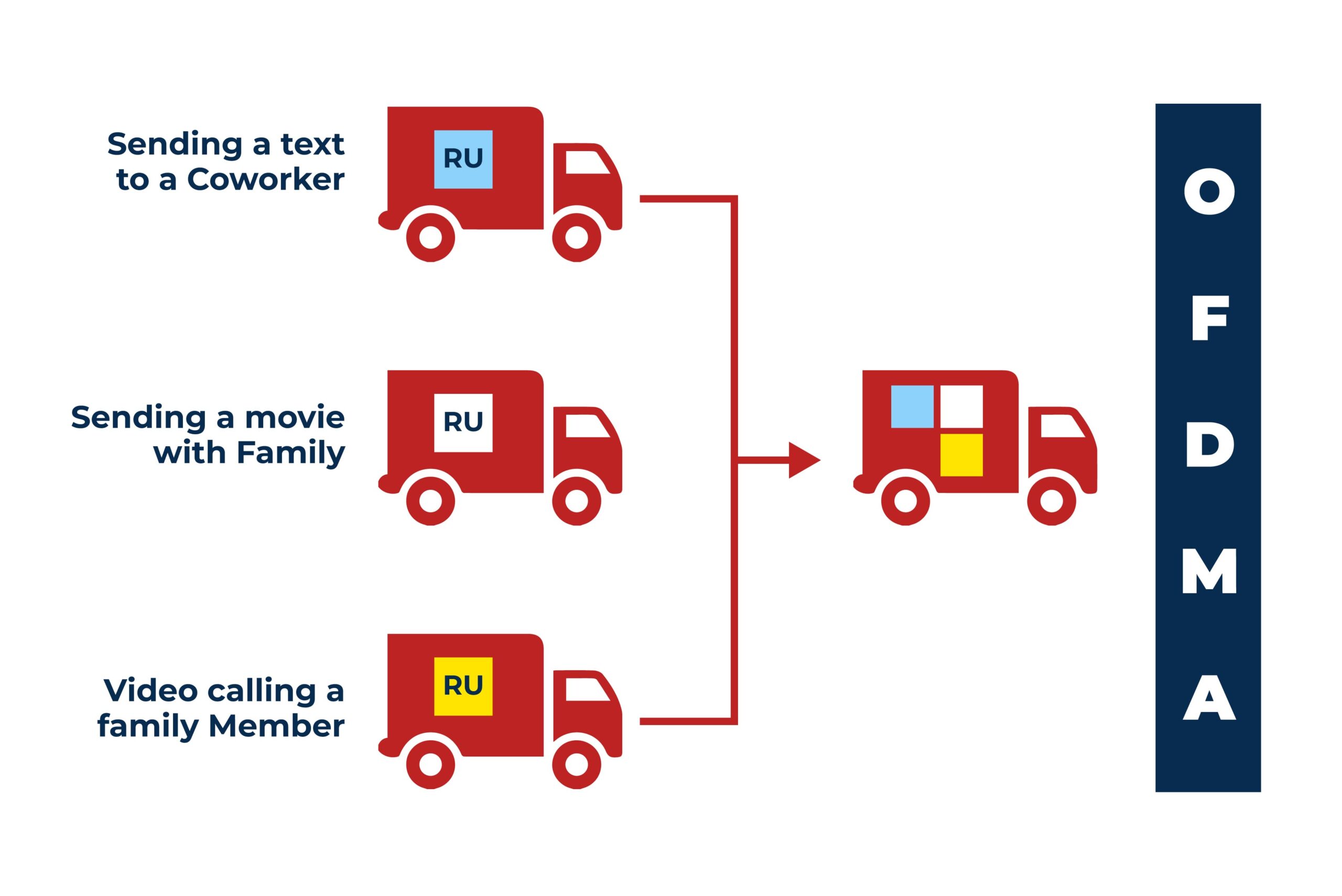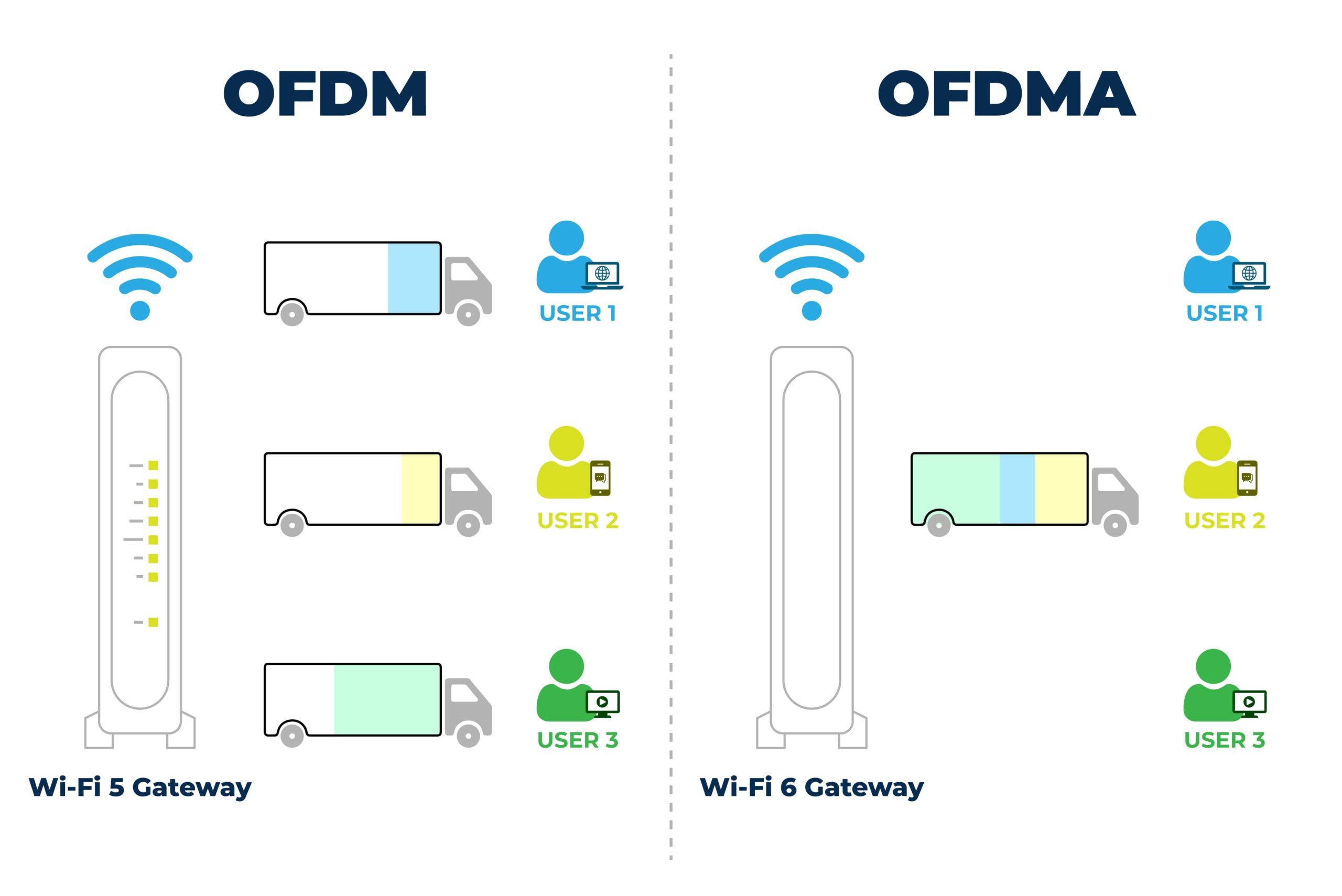What is OFDMA?
Orthogonal frequency-division multiple access (OFDMA) is a feature of WiFi 6 (802.11ax) that allows access points to serve numerous clients simultaneously.
How Does OFDMA Work?

- OFDMA divides the frequency band into smaller subcarriers that don’t interfere with each other; a fast Fourier transform does this division.
- The access point serves as a base station that determines the number of subcarriers to allocate to each user based on factors like channel conditions, data rate requirements, and quality of service.
- Users with better channel conditions or higher data rate demands may be assigned more subcarriers.
- Each user is assigned a group of subcarriers to transmit their data. This enables efficient use of the available spectrum and increases the system’s overall capacity.
Where is OFDMA Used?
- 4G LTE – Used for both downlink & uplink.
- 5G NR – Downlink and uplink transmission, improved spectral efficiency, and better resource allocation.
- WiMAX – WiMAX technology for wireless broadband access over long distances.
- WiFi – WiFi 6, IEEE 802.11ax standard.
- Wireless MAN – Metropolitan Area Network.
- Fixed Wireless Access – Efficient utilization of the available spectrum.
- Cognitive Radio Networks – Dynamically access and utilize the available spectrum bands.
- Internet of Things (IOT) – Transmits small data packets over a shared spectrum for IOT scenarios.
Attributes of OFDMA
Here are some key attributes of OFDMA (Orthogonal Frequency Division Multiple Access):
- Orthogonality: OFDMA relies on the orthogonal frequency subcarriers that not only do not interfere but are also spaced apart. This orthogonality allows multiple subcarriers to be used simultaneously without causing any interference between them.
- Frequency Division: OFDMA divides the frequency spectrum into multiple closely spaced narrowband subchannels instead of a single wide frequency band. Each of the frequency subchannels streams data independently. The division of a wide frequency band enables multiple channels and efficiently utilizes the frequency band.
- Resource Allocation: OFDMA dynamically allocates subcarriers to different users or devices based on their needs and channel conditions. This adaptive resource allocation ensures efficient utilization of the available resources and enhances overall system capacity.
- Flexibility: OFDMA provides flexibility in allocating resources in both the time and frequency domains. It allows for the allocation of different numbers of subcarriers to other users, depending on their data rate requirements.
- Multi-User Access: OFDMA enables multiple users to transmit and receive data simultaneously by assigning different subsets of subcarriers to other users. This multi-user access capability improves system capacity and supports concurrent communication among multiple devices.
- Robustness to Frequency Selective Fading: OFDMA is robust against frequency selective fading, a common phenomenon in wireless communication. By dividing the data into multiple subcarriers, OFDMA mitigates fading effects, improving the system’s overall reliability.
- Adaptive Modulation and Coding: OFDMA supports adaptive modulation and coding, where the modulation scheme and coding rate are dynamically adjusted based on the channel conditions. This adaptation ensures efficient use of the available resources and improves overall system performance.
- Interference Mitigation: OFDMA employs advanced interference mitigation techniques such as subcarrier and power allocation algorithms to minimize interference among users sharing the same frequency band. This interference mitigation helps maintain high-quality communication in dense wireless environments.
These attributes make OFDMA a versatile modulation scheme that provides the following:
- Efficient spectrum utilization.
- Robustness against fading.
- Multi-user access.
- Adaptive resource allocation in various wireless communication systems.
Advantages and Disadvantages of OFDMA
- OFDMA allocates the frequency subchannels to multiple user channels simultaneously, utilizing the frequency band and efficiently using the system’s maximum capacity.
- OFDMA enables the dynamic allocation of subcarriers based on user requirements, channel conditions, and quality of service. This optimizes system performance and adapts to varying traffic patterns.
- By spreading data over a wide frequency range, OFDMA reduces the effects of frequency-selective fading and improves system performance.
- OFDMA allows for concurrent transmission and reception of multiple users within the same frequency band, increasing spectral efficiency and user capacity.
What is MU-MIMO?
Every internet user has faced the phenomenon that the slower it moves when more devices connect to your home WiFi. The reason is most routers can only communicate with one device simultaneously. With single-user (SU-MIMO) routers, each device waits for its turn to send and receive data over the internet; whenever a new device connects, the line—and the wait—becomes a little longer. MU-MIMO technology resolves this issue by reducing wait time.
MU-MIMO (Multi-User Multiple-Input Multiple-Output) is used in wireless communication systems, particularly in WiFi networks and cellular networks like 4G and 5G. It enables multiple users to simultaneously transmit or receive data using multiple antennas, improving system capacity and overall performance.
How Does MU-MIMO Work?
MU-MIMO (Multi-User Multiple-Input Multiple-Output) technology uses multiple antennas at the access point and client devices to communicate simultaneously with multiple users. It groups users based on favorable channel conditions, applies precoding and beamforming techniques to optimize transmissions, and allows for concurrent data streams to multiple users. This enhances system capacity, reduces latency, and improves network efficiency.
OFDMA vs. MU-MIMO: Key Comparisons and Similarities
OFDMA (Orthogonal Frequency Division Multiple Access) and MU-MIMO (Multi-User Multiple-Input Multiple-Output) are important technologies in wireless communication systems. While they serve different purposes, they have some key comparisons and similarities:
i) Purpose
- OFDMA: OFDMA is primarily focused on efficient spectrum utilization and resource allocation. It divides the frequency spectrum into smaller subchannels to allow multiple users to be served simultaneously.
- MU-MIMO: MU-MIMO is designed to enable simultaneous communication with multiple users using multiple antennas. It enhances system capacity and improves overall performance by leveraging spatial multiplexing.
ii) Multiple User Support
- OFDMA: OFDMA allows for concurrent transmission and reception of multiple users within the same frequency band. It enables multiple users to share the available spectrum efficiently.
- MU-MIMO: MU-MIMO allows simultaneous communication with multiple users using multiple antennas. It serves multiple users concurrently, enhancing system capacity and user experience.
iii) Spatial Dimension
- OFDMA: OFDMA does not rely on the spatial dimension. It focuses on dividing the frequency spectrum into subchannels and efficiently allocating resources to different users.
- MU-MIMO: MU-MIMO explicitly utilizes multiple antennas to leverage the spatial dimension. It employs precoding and beamforming techniques to separate data streams for different users and enhance signal quality.
iv) Implementation
- OFDMA: OFDMA is commonly used in cellular networks like 4G and 5G, and WiFi networks. It requires both the network infrastructure and user devices to support OFDMA.
- MU-MIMO: MU-MIMO is used in WiFi networks and cellular networks. The access point, base station, and client devices require multiple antennas to enable simultaneous communication.
v) Performance Impact
- OFDMA: OFDMA improves spectral efficiency and accommodates multiple users efficiently. It optimizes resource allocation based on user requirements and channel conditions.
- MU-MIMO: MU-MIMO enhances system capacity by serving multiple users simultaneously. It improves overall network performance and user experience, particularly in high-density environments.
OFDMA vs. MU-MIMO: Notable Similarities
Although there are some notable similarities, it’s important to note that OFDMA and MU-MIMO are distinct technologies with different implementations and characteristics.
OFDMA primarily focuses on dividing the frequency spectrum, whereas MU-MIMO utilizes multiple antennas for spatial multiplexing. Each technology has unique advantages and uses cases, often employed together in modern wireless systems to maximize performance.
FAQS
OFDMA, or Orthogonal Frequency Division Multiple Access, is a crucial technology in wireless communication systems. Allowing multiple users to share and transfer data over the same frequency band through unique subsets of subcarriers significantly improves efficiency and increases capacity. This results in reduced interference and overall network performance enhancement. OFDMA is vital in wireless communication standards, including WiMAX, LTE, and WiFi 6.
OFDMA (orthogonal frequency-division multiple access), a technology in WiFi 6, improves wireless network performance by independently modulating subcarriers within frequencies.
Enabling OFDMA is a total game-changer for your WiFi network! It's like turbocharging your connection. With OFDMA, your network gets superpowers to handle many devices without breaking a sweat. It slices and dices the frequency spectrum into smaller chunks, making your network more efficient and zapping latency. So, if you've got a bunch of gadgets hogging the bandwidth or crave lightning-fast speeds, flip that OFDMA switches and watch your network soar. Don't miss out on the wireless revolution – enable OFDMA today and rock your WiFi world!
Consider enabling OFDMA on your router if your devices support it and you have many connected devices or bandwidth-intensive activities. It can improve network performance, allocate resources efficiently, and future-proof your network. Perform testing to evaluate its impact on throughput and latency.
OFDMA solves the problems of inefficient spectrum utilization, multi-user interference, latency, device density, and throughput capacity in wireless networks. It maximizes spectrum utilization, reduces interference, decreases latency, handles high device density, and improves overall network performance.
Yes. OFDMA is used in the 5G New Radio (5G NR) air interface stage, allowing for mobile connectivity. OFDM, the older technology, is one of the primary enabling technologies of 3G and 4G cellular service.
OFDMA makes a significant difference in wireless communication by increasing network capacity, improving spectral efficiency, reducing interference, lowering latency, and enhancing the overall user experience.
MU-MIMO (Multi-User Multiple Input Multiple Output) and OFDMA (Orthogonal Frequency Division Multiple Access) can be used together in wireless networks. They are often implemented together to enhance network performance and efficiency further.
MU-MIMO utilizes spatial multiplexing and increases throughput by transmitting separate data streams to different users or devices.
OFDMA, on the other hand, maximizes spectrum utilization and increases overall network capacity. It allows for parallel transmission from multiple users or streams by allocating subchannels to each user.

OFDM divides data into parallel streams for efficient transmission. OFDMA adds the ability for multiple users to transmit at the same time by splitting the frequency spectrum into smaller subchannels. OFDM is used in different wireless systems, while OFDMA is specifically for multi-user scenarios in advanced wireless systems.


